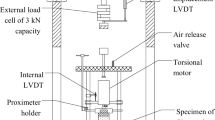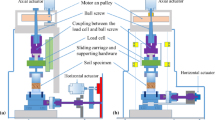Abstract
Marine clay supporting high-temperature offshore structure susceptible to random movements (such as a buckling high-temperature pipeline) experiences variable shearing rates at an elevated temperature that is higher than the marine environment (typically 4 °C). This practically implies that the undrained shear strength (su) of the marine clay being routinely characterized in situ by penetrometers at a constant rate under an isothermal condition (4 °C) should be carefully corrected, by taking into account the temperature and rate dependency. To date, the combined effects of rate and temperature on the undrained shear behaviour of marine clay are merely investigated experimentally and theoretically. This study presents the development of an anisotropic thermo-elastic–viscoplastic model and a series of temperature- and rate-controlled triaxial tests for validation purpose. Compared to the modified Cam-Clay model, the proposed model only introduces three new parameters to characterize the temperature dependency, rate dependency and the inherent anisotropy of K0-consolidated marine clay. The predictive capability of the model has been validated by the triaxial test results. Based on the new model, an explicit equation is formulated for quantifying the temperature- and rate-dependent su of marine clay. Calculation charts are also developed to quantify su of marine clay with different plasticity indexes under various strain rates and temperatures.
















Similar content being viewed by others
References
Abuel-Naga HM, Bergado DT, Lim BF (2007) Effect of temperature on shear strength and yielding behaviour of soft Bangkok clay. Soils Found 47(3):423–436
Abuel-Naga HM, Bergado DT, Bouazza A, Pender M (2009) Thermomechanical model for saturated clays. Géotechnique 59(3):273–278
Atkinson JH (2000) Non-linear soil stiffness in routine design. Géotechnique 50(5):487–507
Bjerrum L (1967) Engineering geology of Norwegian normally consolidated marine clays as related to the settlements of buildings. Géotechnique 17(2):83–118
Boudali M, Leroueil S, Srinivasa Murthy BR (1994) Viscous behaviour of natural clays. In: Proceedings of 13th international conference on soil mechanics and foundation engineering, New Delhi, A. A. Balkema, Rotterdam, the Netherlands, vol 1, pp 411–416
British Standard 1377 (1990) Methods of test for soils for civil engineering purposes. British Standards Institution, London
Campanella RG, Mitchell JK (1968) Influence of temperature variations on soil behaviour. J Soil Mech Found Div ASCE 94(3):709–734
Cekerevac C, Laloui L (2004) Experimental study of thermal effects on the mechanical behaviour of a clay. Int J Numer Anal Methods Geomech 28(3):209–228
Cekerevac C, Laloui L, Vulliet L (2005) A novel triaxial apparatus for thermo-mechanical testing of soils. Geotech Test J 28(2):161–170
Chen YN, Yang ZX (2017) A family of improved yield surfaces and their application in modeling of isotropically over–consolidated clays. Comput Geotech 90:133–143
Chung SF, Randolph MF (2004) Penetration resistance in soft clay for different shaped penetrometers. In: Proceedings of the second international conference on site characterisation, Porto, vol 1, pp 671–678
Cui YJ, Sultan N, Delage P (2000) A thermomechanical model for saturated clays. Can Geotech J 37(3):607–620
Dong Y, Lu N, Mccartney JS (2018) Scaling shear modulus from small to finite strain for unsaturated soils. J Geotech Geoenviron Eng 144(2):04017110
Eriksson LG (1989) Temperature effects on consolidation properties of sulphide clays. In: Proceedings of the 12th international conference on soil mechanics and foundation engineering, Rio de Janeiro, Balkema, Rotterdam, Brookfield, vol 3, pp 2087–2090
Gao ZW, Zhao JD, Yin ZY (2016) Dilatancy relation for over-consolidated clay. Int J Geomech 17(5):06016035
Gao Z, Zhao JD, Yin ZY (2016) Dilatancy relation for overconsolidated clay. Int J Geomech 17(5):06016035
Graham J, Tanaka N, Crilly T, Alfaro M (2001) Modified Cam-Clay modelling of temperature effects in clays. Can Geotech J 38(3):608–621
Grimstad G, Degago SA, Nordal S, Karstunen M (2010) Modeling creep and rate effects in structured anisotropic soft clays. Acta Geotech 5(5):69–81
Hinchberger SD, Rowe RK (2005) Evaluation of the predictive ability of two elastic–viscoplastic constitutive models. Can Geotech J 42(6):1675–1694
Hong Y, Koo CH, Zhou C, Ng CWW, Wang LZ (2017) Small strain path-dependent stiffness of toyoura sand: laboratory measurement and numerical implementation. Int J Geomech 17(1):04016036
Hong Y, Wang LZ, Zhang JF, Gao ZW (2020) Forthcoming. 3D elastoplastic model for fine-grained gassy soil considering the gas-dependent yield surface shape and stress-dilatancy. J Eng Mech. https://doi.org/10.1061/(ASCE)EM.1943-7889.0001760
Hueckel T, Baldi G (1990) Thermoplasticity of saturated clays: experimental constitutive study. J Geotech Geoenviron Eng ASCE 116(2):1778–1796
Hueckel T, Pellegrini R (1991) Thermo–plastic modeling of undrained failure of saturated clay due to heating. Soils Found 31(3):1–16
Jáky J (1944) The coefficient of earth pressure at rest. J Soc Hung Arch Eng 355–358 (in Hungarian)
Kelln C, Sharma J, Hughes D, Graham J (2008) An improved elastic–viscoplastic soil model. Can Geotech J 45(10):1356–1376
Kim YH, Hossain MS, Wang D (2015) Effect of strain rate and strain softening on embedment depth of a torpedo anchor in clay. Ocean Eng 108:704–715
Laloui L, François B (2009) ACMEG-T: soil thermoplasticity model. J Eng Mech 135(9):932–944
Laloui L, Leroueil S, Chalindar S (2008) Modelling the combined effect of strain rate and temperature on one-dimensional compression of soils. Can Geotech J 45(12):1765–1777
Leoni M, Karstunen M, Vermeer PA (2008) Anisotropic creep model for soft soils. Géotechnique 58(3):215–226
Leroueil S, Marques MES (1996) Importance of strain rate and temperature effects in geotechnical engineering. In: Sheahan TC, Kallakin VN (eds) Proceedings of the measuring and modeling time dependent soil behavior. ASCE, Reston, VA, pp 1–60
Liu H, Liu HL, Xiao Y, McCartney JS (2018) Influence of temperature on the volume change behavior of saturated sand. Geotech Test J 41(4):747–758
Liu H, Liu HL, Xiao Y, McCartney JS (2018) Effects of temperature on the shear strength of saturated sand. Soils Found 2018(58):1326–1338
Marques MES, Leroueil S, Soares de Almeida MDS (2004) Viscous behaviour of St-Roch-de-l’Achigan clay, Quebec. Can Geotech J 41(1):25–38
Mašín D, Khalili N (2012) A thermo-mechanical model for variably saturated soils based on hypoplasticity. Int J Numer Anal Methods Geomech 36(12):1461–1485
Mesri G, Castro A (1987) Cα/Cc concept and K0 during secondary compression. J Geotech Eng 113(3):230–247
Moritz L (1995) Geotechnical properties of clay at elevated temperatures. Report: 47, Swedish Geotechnical Institute, Linköping
Ng CWW, Wang SH, Zhou C (2016) Volume change behaviour of saturated sand under thermal cycles. Géotech Lett 6(2):124–131
Reda A, Forbes G (2012) Investigation into the dynamic effects of lateral buckling of high temperature/high pressure offshore pipelines. In: Proceedings of acoustics 2012, Fremantle, Australia
Tan GB, Wang DG, Liu SH et al (2013) Frictional behaviors of rough soft contact on wet and dry pipeline surfaces: with application to deepwater pipelaying. Sci China Technol Sci 56(12):3024–3032
Tidfors M, Sällfors G (1989) Temperature effect on preconsolidation pressure. Geotech Test J 12(1):93–97
Tsutsumi A, Tanaka H (2012) Combined effects of strain rate and temperature on consolidation behavior of clayey soils. Soils Found 52(2):207–215
Wang LZ, Dan HB, Li LL (2012) Modeling strain-rate dependent behaviour of K0-consolidated soft clays. J Eng Mech ASCE 138(7):738–748
Wang LZ, Wang KJ, Hong Y (2016) Modeling temperature-dependent behavior of soft clays. J Eng Mech ASCE 142(8):04016054
Wang S, Wu W, Yin ZY, Peng C, He XZ (2018) Modelling the time-dependent behaviour of granular material with hypoplasticity. Int J Numer Anal Methods Geomech. https://doi.org/10.1002/nag.2793
Wheeler SJ, Näätänen A, Karstunen M, Lojander M (2003) An anisotropic elastoplastic model for soft clays. Can Geotech J 40(2):403–418
Wood DM (1990) Soil behaviour and critical state soil mechanics. Cambridge University Press, Cambridge
Xiong YL, Ye GL, Zhu HH, Zhang S, Zhang F (2016) Thermo-elastoplastic constitutive model for unsaturated soils. Acta Geotech 11(6):1287–1302
Yao YP, Lu D, Zhou AN, Zou B (2004) Generalized non-linear strength theory and transformed stress space. Sci China 47(6):691–709
Yao YP, Hou W, Zhou AN (2009) UH model: Three-dimensional unified hardening model for overconsolidated clays. Géotechnique 59(5):451–469
Yao YP, Gao ZW, Zhao JD, Wan Z (2012) Modified UH Model: Constitutive Modeling of Overconsolidated Clays Based on a Parabolic Hvorslev Envelope. J Geotech Geoenviron Eng 138(7):860–868. https://doi.org/10.1061/(ASCE)GT.1943-5606.0000649
Yao YP, Zhou AN (2013) Non-isothermal unified hardening model: a thermo -elasto-plastic model for clays. Géotechnique 63(15):1328–1345
Yashima A, Leroueil S, Oka F, Guntoto I (1998) Modelling the temperauture and strain rate dependent behavior of clays: one dimensional consolidation. Soils Found 38(2):63–73
Yin ZY, Wang JH (2012) A one-dimensional strain-rate based model for soft structured clays. Sci China Technol Sci 55(1):90–100
Yin ZY, Chang CS, Karstunen M, Hicher PY (2010) An anisotropic elastic–viscoplastic model for soft clays. Int J Solids Struct 47(5):665–677
Yin ZY, Karstunen M, Chang CS, Koskinen M, Lojander M (2011) Modeling time-dependent behavior of soft sensitive clay. J Geotech Geoenviron Eng 137(11):1103–1113
Yin ZY, Zhu Q, Yin J, Ni Q (2014) Stress relaxation coefficient and formulation for soft soils. Géotech Lett 4(1):45–51
Yin ZY, Zhu QY, Zhang DM (2017) Comparison of two creep degradation modeling approaches for soft structured soils. Acta Geotech 12(6):1395–1413
Yu B, Wang Y, Zhang J, Liu X, Zhang Z, Wang K (2008) Thermal impact of the products pipeline on the crude oil pipeline laid in one ditch—the effect of pipeline interval. Int J Heat Mass Trans 51(3–4):597–609
Zhou AN, Sheng D, Li J (2014) Modelling water retention and volume change behaviours of unsaturated soils in non-isothermal conditions. Comput Geotech 55:1–13
Zhou C, Ng CWW, Chen R (2015) A bounding surface plasticity model for unsaturated soil at small strains. Int J Numer Anal Meth Geomech 39(11):1141–1164
Zhou C, Ng CWW, Wang S (2017) Modelling volume changes of sand under thermal loads: a preliminary attempt. Géotech Lett 7(1):1–5
Zhu JG, Yin JH (2000) Strain-rate dependent stress–strain behaviour of overconsolidated Hong Kong marine clay. Can Geotech J 37(6):1272–1282
Zhu QY, Yin ZY, Hicher PY, Shen SL (2016) Nonlinearity of one-dimensional creep characteristics of soft clays. Acta Geotech 11(4):887–900
Acknowledgements
The authors gratefully acknowledge the financial supports from National Key Research and Development Programme (Grant No. 2016YFC0800200), National Natural Science Foundation of China (51939010 and 51779221), Key Research and Development Programme of Zhejiang Province (2018C03031) and Key Science and Technology Plan of PowerChina Huadong Engineering Corporation (KY2018-ZD-01) and Zhejiang Provincial Natural Science Foundation (LQ20E090001 and LHZ20E090001).
Author information
Authors and Affiliations
Corresponding author
Additional information
Publisher's Note
Springer Nature remains neutral with regard to jurisdictional claims in published maps and institutional affiliations.
Rights and permissions
About this article
Cite this article
Wang, K., Wang, L. & Hong, Y. Modelling thermo-elastic–viscoplastic behaviour of marine clay. Acta Geotech. 15, 2415–2431 (2020). https://doi.org/10.1007/s11440-020-00917-9
Received:
Accepted:
Published:
Issue Date:
DOI: https://doi.org/10.1007/s11440-020-00917-9




